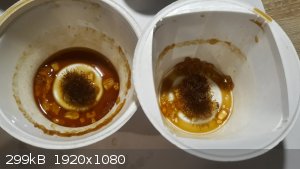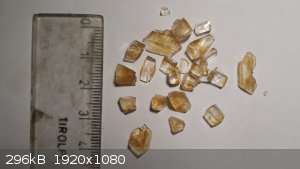metalresearcher
National Hazard
   
Posts: 758
Registered: 7-9-2010
Member Is Offline
Mood: Reactive
|
|
K2CO3 / KOH from Wood ashes ?
I tried to extract soluble salts from wood ash.
I filled one third bucket with ashes from burnt beech + oak logs in my woodstove, added 2 liters of water and let it stand for over an hour and shaked
the bucket a little.
Then I decanted off most liquid which I filtered through a coffee filter and a blob of Kaowool in the stem of the funnel (replacement for cotton which
I don't have as it is as inert) to prevent tearing the filter when pouring in as it is very vulnerable when wet.
A clear tea-like brownish liquid which was about 800ml and felt very slippery, so it is moderately basic.
The color is probably due to Fe3+ ions.
But now my question: how can I separate K+ ions from this liquid ?
[Edited on 2021-2-7 by metalresearcher]
|
|
|
unionised
International Hazard
    
Posts: 5128
Registered: 1-11-2003
Location: UK
Member Is Offline
Mood: No Mood
|
|
The brown colour is more likely to me "humic acid" and or caramel like stuff than Iron.
Fe(OH)3 is very insoluble, and the solution is basic.
Probably the best bet for "what to do next" is put the solution in a shallow tray (glass or plastic) and let the water evaporate.
If you have some hydrogen peroxide, it might be interesting to see if that bleaches the colour at all.
Since K2CO3 is hygroscopic, I don't think you will get crystals forming unless you heat it to drive off water.
If you boil off all the water then you can roast the product- that will degrade the organics to carbon which is insoluble.
It also gives you a chance to weigh the product.
You might decide there's not enough material to be worth doing anything with.
The most practical way to convert it to KOH is to add Ca(OH)2 to the potash.
https://pubs.acs.org/doi/pdf/10.1021/ie51398a020
|
|
|
draculic acid69
International Hazard
    
Posts: 1371
Registered: 2-8-2018
Member Is Offline
|
|
After dissolving the ashes and filtering you evaporate to dryness followed by blowtorching of the residue to redheat or something then purification
|
|
|
draculic acid69
International Hazard
    
Posts: 1371
Registered: 2-8-2018
Member Is Offline
|
|
The Canadian chemist on YouTube did a video on it I think
|
|
|
EverythingAl2O3
Hazard to Self
 
Posts: 51
Registered: 3-9-2019
Member Is Offline
|
|
| Quote: |
I tried to extract soluble salts from wood ash.
I filled one third bucket with ashes from burnt beech + oak logs in my woodstove, added 2 liters of water and let it stand for over an hour and shaked
the bucket a little.
Then I decanted off most liquid which I filtered through a coffee filter and a blob of Kaowool in the stem of the funnel (replacement for cotton which
I don't have as it is as inert) to prevent tearing the filter when pouring in as it is very vulnerable when wet.
A clear tea-like brownish liquid which was about 800ml and felt very slippery, so it is moderately basic.
The color is probably due to Fe3+ ions. But now my question: how can I separate K+ ions from this liquid ?
|
I did something like this for a liming agent for my garden but not to the degree of purity that you might be going for. Its actually pretty simple.
The preliminary leaching gets most contaminants out because they are insoluble. If you want a really pure K2CO3 then you could take your solution and
add dry ice or bubble CO2 into it. This will precipitate out any KAl(OH)4 that formed as Al(OH)3 or Al2O3 (papers I read on making Al2O3 disagreed)
and any Ca(OH)2 in solution will precipitate out as CaCO3. Some K2CO3 can precipitate out at the beginning because it has pH dependent solubility and
is competing with the remaining KOH, but it can be recovered by dissolving the precipitate mix in distilled water (CaCO3 and Al(OH)3 will not go back
in).
Then if you want the K2CO3 back as KOH add Ca(OH)2.
This is where I stopped the purification process because the plants don't care too much about the source of base as long as it isn't Na. Depending on
your location Na could be a large contaminant (if you live in an area where your soil is inherently basic pH 7-8.5 then Na is likely to be a big
contaminant. If the soils are naturally acid then it should be negligible. Seeing as you burned beech and oak they likely originated from an acid
soil) but the other significant contaminant will be CaCl2 salts. I have not worked on how to separate them. The brown is likely leftover organics like
Unionised said. Likely leftover lignin or polyphenols which are quite thermally stable and if the fire did not have the right amount of air they would
not oxidize. A blow torch should solve that issue if you have one.
[Edited on 9-2-2021 by EverythingAl2O3]
|
|
|
Maurice VD 37
Hazard to Self
 
Posts: 66
Registered: 31-12-2018
Member Is Offline
|
|
The wood ashes have the following composition :
40 - 70 % CaCO3
5 - 10% K2CO3
5 - 10 % Na2CO3
5 - 10% MgCO3
2 - 19% MgCO3
2 - 20% SiO2
2 - 6% Ca3(PO4)2
1 - 4% Mg3(PO4)2
1 - 5% K2SO4
0 - 2% AlPO4
0 - 1% FePO4
|
|
|
metalresearcher
National Hazard
   
Posts: 758
Registered: 7-9-2010
Member Is Offline
Mood: Reactive
|
|
Quote: Originally posted by Maurice VD 37  | The wood ashes have the following composition :
40 - 70 % CaCO3
5 - 10% K2CO3
5 - 10 % Na2CO3
5 - 10% MgCO3
2 - 19% MgCO3
2 - 20% SiO2
2 - 6% Ca3(PO4)2
1 - 4% Mg3(PO4)2
1 - 5% K2SO4
0 - 2% AlPO4
0 - 1% FePO4 |
So much CaCO3 and MgCO3 ?
How did you determine this ?
I checked the pH of the filtered wood ash solution and it was rather basic: 12.5, so that can't contain so much CaCO3 and MgCO3.
Here a picture after boiling off the water from 200ml of solution, yield about 9 grams.
 
|
|
|
clearly_not_atara
International Hazard
    
Posts: 2799
Registered: 3-11-2013
Member Is Offline
Mood: Big
|
|
I assume Maurice gave a literature composition for the solid ashes, not the leachings. There is usually plenty of calcium in wood ashes, but CaCO3
does not dissolve in water.
|
|
|
unionised
International Hazard
    
Posts: 5128
Registered: 1-11-2003
Location: UK
Member Is Offline
Mood: No Mood
|
|
Quote: Originally posted by Maurice VD 37  | The wood ashes have the following composition :
40 - 70 % CaCO3
5 - 10% K2CO3
5 - 10 % Na2CO3
5 - 10% MgCO3
2 - 19% MgCO3
2 - 20% SiO2
2 - 6% Ca3(PO4)2
1 - 4% Mg3(PO4)2
1 - 5% K2SO4
0 - 2% AlPO4
0 - 1% FePO4 |
I'd not expect that much sodium.
|
|
|
Maurice VD 37
Hazard to Self
 
Posts: 66
Registered: 31-12-2018
Member Is Offline
|
|
The analysis I have reported describe the composition of the solid ashes, before any leaching or treatment. The basicity of the solution is due to the
carbonates of sodium and potassium. I have also been surprised about the amount of sodium.
|
|
|
Plinius
Harmless

Posts: 4
Registered: 11-1-2021
Member Is Offline
|
|
When the solution is evaporated K2SO4 crystallizes out first. The amount of K2SO4 obtained is about 10% of the total amount of salts. The yield of
K2CO3 I have obtained agrees with the analysis presented above.
I once read that ash from birch or beech is best. Ash from coniferous trees is not so good, why I do not know.
|
|
|
Piroz
Harmless

Posts: 19
Registered: 15-12-2020
Location: Poland
Member Is Offline
|
|
Treating solution with CO2 is a great idea. I found that alcoholic fermentation is good source of CO2. So I decided to treat small portions of
concentrated solution from wood ashes with carbon dioxide from carboy. Next the solution with crystalline precipiptation was collected in the bottle.
Then I carefully left solution for slowly crystallisation in open containers and I found something interesting. The first crystals that grew were
pillars- like(or needle- like). I'm sure that isn't carbonate or bicarbonate due to no generation of CO2 in reaction with acetic acid. Also the
crystal shape doesn't looks like any sulfate, more looks like phosphate. After some time the second type of crystals (flat) starts to grow. It looks
like potassium bicarbonate- they violently react with acetic acid to form CO2 and give lilac colour of flame. After heating in open flame it forms
snowy-white compound, very hygroscopic (some particles made mess on the table after few minutes). However it also contains traces of sodium that give
some yellow flame. Needle-like crystals also gives the yellow colour of flame but stronger so sodium content is higher.
I think that's the best way to get potassium carbonate from wood ash- by separation of potassium bicarbonate using slowly crystallisation and then
heating it to obtain carbonate.
I'm also not sure about first crystals that separates out on the bottom of bottle. I'll try to crystallise it after dissolve in water.
Edit: it looks like sodium occurs as sodium-potassium carbonate mix
| Quote: |
A Potassium sodium carbonate, K2CO3,Na2CO3,12H2O, is a constituent of vegetable ashes. At 35° C. it decomposes in accordance with the equation
3(K2CO3,Na2CO3,12H2O) = 2K2CO3 + K2CO3,3Na2CO3,10H2O + 26H2O.
The double carbonate thus generated decomposes at a temperature of about 130° C.
|
source: http://potassium.atomistry.com/potassium_sodium_carbonate.html
But I'm suprised that is 5 - 10 % of Na2CO3, it's large amount. It doesn't look like so much sodium.
       
[Edited on 11-2-2021 by Piroz]
[Edited on 12-2-2021 by Piroz]
[Edited on 12-2-2021 by Piroz]
|
|
|
Plinius
Harmless

Posts: 4
Registered: 11-1-2021
Member Is Offline
|
|
I once read a description of potash production from - I think - the 19th century. It was mentioned that if the wet ashes were stored for some weeks in
contact with air, the yield of K2CO3 was increased. The reason given was that the carbon dioxide absorbed from the air decomposed silicates present in
the ash.
I have never seen crystals which look like needles when making potash.
|
|
|